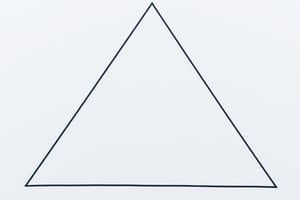Podcast
Questions and Answers
Which statement about the Pythagorean theorem is true?
Which statement about the Pythagorean theorem is true?
- It can only determine the hypotenuse if two sides are known. (correct)
- It requires all angles of the triangle to be right angles.
- It applies to all types of triangles.
- It can determine lengths in non-right triangles.
What does the Triangle Inequality Theorem state?
What does the Triangle Inequality Theorem state?
- The sum of the lengths of any two sides must be greater than the length of the third side. (correct)
- All sides must be equal in length.
- The longest side must be opposite the largest angle.
- The sum of the interior angles must be 360 degrees.
Which of the following conditions indicates that two triangles are congruent?
Which of the following conditions indicates that two triangles are congruent?
- All angles are different.
- The lengths of all three sides are equal. (correct)
- One side is equal in length to the longest side of another triangle.
- At least two angles are equal.
Which triangle configuration is considered isosceles?
Which triangle configuration is considered isosceles?
Under which condition does an obtuse triangle exist?
Under which condition does an obtuse triangle exist?
Which of the following represents the hypotenuse in a right triangle?
Which of the following represents the hypotenuse in a right triangle?
What type of triangle has all sides and angles different?
What type of triangle has all sides and angles different?
In triangle congruence, what does the 'HL' condition indicate?
In triangle congruence, what does the 'HL' condition indicate?
How many degrees are in the sum of the interior angles of any triangle?
How many degrees are in the sum of the interior angles of any triangle?
Flashcards are hidden until you start studying
Study Notes
Triangles
Pythagorean Theorem
- Formula: ( a^2 + b^2 = c^2 )
- Where ( c ) is the hypotenuse of a right triangle, and ( a ) and ( b ) are the lengths of the other two sides.
- Applicable only to right triangles.
- Used to determine the length of one side when the other two sides are known.
Properties of Triangles
- The sum of the interior angles is always ( 180^\circ ).
- The exterior angle is equal to the sum of the two opposite interior angles.
- The shortest side is opposite the smallest angle; the longest side is opposite the largest angle.
- Triangle Inequality Theorem: The sum of the lengths of any two sides must be greater than the length of the third side.
Triangle Congruence
- Two triangles are congruent if they have:
- SSS: Three sides equal.
- SAS: Two sides and the included angle equal.
- ASA: Two angles and the included side equal.
- AAS: Two angles and a non-included side equal.
- HL: The hypotenuse and one leg equal (only for right triangles).
- Congruent triangles have the same shape and size.
Types of Triangles
-
Based on Sides:
- Equilateral: All sides are equal; all angles are ( 60^\circ ).
- Isosceles: Two sides are equal; two angles are equal.
- Scalene: All sides and angles are different.
-
Based on Angles:
- Acute: All angles are less than ( 90^\circ ).
- Right: One angle is exactly ( 90^\circ ).
- Obtuse: One angle is greater than ( 90^\circ ).
Pythagorean Theorem
- The Pythagorean Theorem is expressed by the formula ( a^2 + b^2 = c^2 ).
- Hypotenuse ( c ) is the longest side of a right triangle, while ( a ) and ( b ) represent the other two sides.
- This theorem is applicable solely to right triangles, allowing the calculation of an unknown side length when the other two sides are known.
Properties of Triangles
- The interior angles of any triangle always total ( 180^\circ ).
- An exterior angle of a triangle is equivalent to the sum of the two non-adjacent interior angles.
- The shortest side of a triangle is always opposite the smallest angle, and the longest side is opposite the largest angle.
- According to the Triangle Inequality Theorem, the combined lengths of any two sides must exceed the length of the remaining side.
Triangle Congruence
- Two triangles are congruent if they meet specific criteria:
- SSS (Side-Side-Side): All three sides are equal in length.
- SAS (Side-Angle-Side): Two sides and the included angle are equal.
- ASA (Angle-Side-Angle): Two angles and the included side are equal.
- AAS (Angle-Angle-Side): Two angles and a non-included side are equal.
- HL (Hypotenuse-Leg): Hypotenuse and one leg are equal (specific to right triangles).
- Congruent triangles share identical shape and size characteristics.
Types of Triangles
-
By Sides:
- Equilateral: All sides and angles are equal; each angle measures ( 60^\circ ).
- Isosceles: Two sides are equal in length, resulting in two equal angles.
- Scalene: All sides and angles are distinct and differ from one another.
-
By Angles:
- Acute: All angles measure less than ( 90^\circ ).
- Right: Contains one angle that is precisely ( 90^\circ ).
- Obtuse: Has one angle that exceeds ( 90^\circ ).
Studying That Suits You
Use AI to generate personalized quizzes and flashcards to suit your learning preferences.




